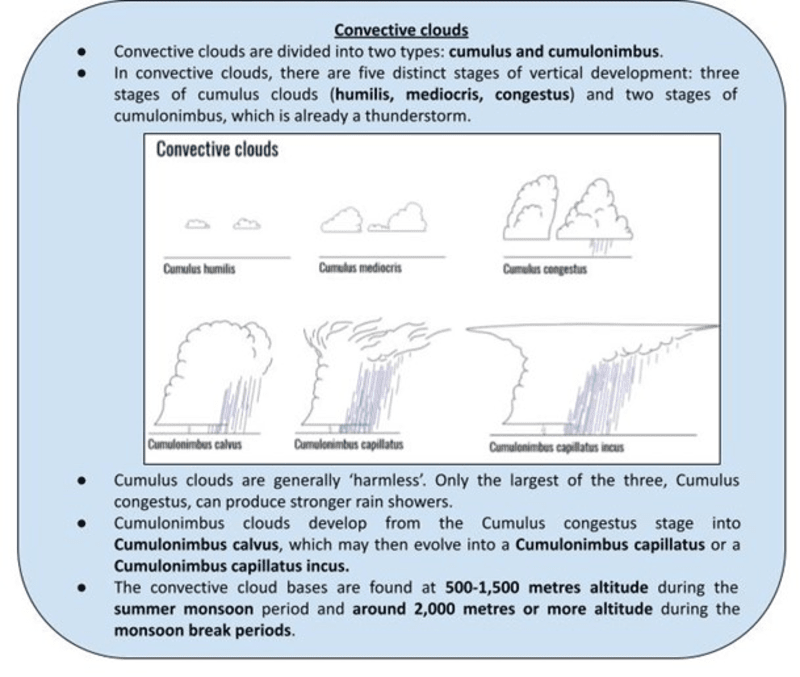India’s first dist-level study on hypertension flags disparities in care
Relevance: GS I and II (Social Issues and Justice; Health)
Why in News?
Recently, a district-wise analysis of hypertension has been conducted which flags disparities in healthcare practices in India.
- According to a recent WHO report, 188.3 million people in India suffer from hypertension but only 37% get diagnosed, only 30% start treatment, and only 15% manage to keep their blood pressure under control.
About the Report/study:
- For the first time in India, a district-level study on hypertension was published in JAMA Network by the American Medical Association conducted by AIIMS Delhi in collaboration with scientists from Europe and the US.
- The scientists used the hypertension data from NFHS-5 as a base report, which was released in May 2022.
- An output dashboard was created as a part of the study and has gender-wise, area-wise educational levels data on hypertension as shown below:
|
Key Outcomes from the Report:
|
What is the significance of this report/study?
- Previously, many state-based analyses were made and studied. However, the district-wise analysis is important to highlight “the heterogeneity” within states and particularly the regions.
- With the help of this new dashboard, every district will gain momentum in its policy and healthcare implementation programmes.
- This will help the Indian government to record the database and seek the issue of gender and socio-demographic disparities.'
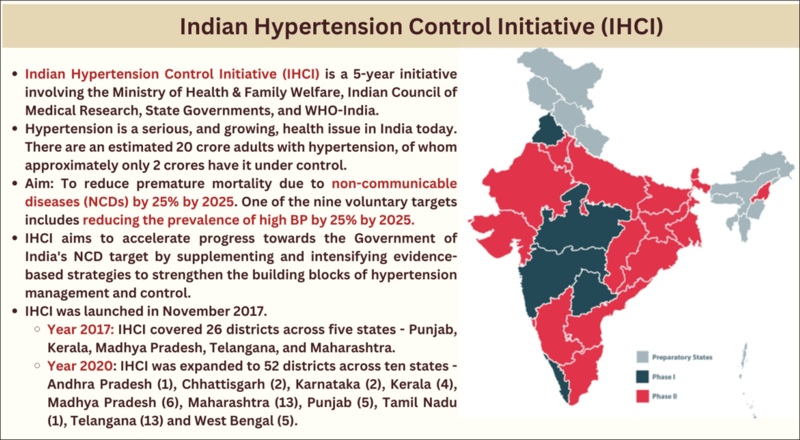
Way Forward:
- Need to increase the number of registrations and coverage: To Promote opportunistic screening and assign the support staff in every health facility to check the blood pressure of all adults visiting the facility.
- Need to have a database for every visit: Encourage the use of IT tools for better documentation of visits and send periodic automated reminders for patients who did not return for follow-up visits.
- Need to improve Blood pressure control Rate: Improve compliance to State-specific Hypertension treatment protocol at all levels of facilities in the public sector.
- Need to improve the availability of Drugs: Identify the gaps in procurement systems and strengthen systems to procure annual requirements of drugs based on rational forecasting on time.
PYQ’s
- Appropriate local community-level healthcare intervention is a prerequisite to achieving ‘Health for All’ in India. Explain (2018)
- “Besides being a moral imperative of a Welfare State, primary health structure is a necessary precondition for sustainable development.” Analyse. (2021)
India pitches for a clear definition of e-commerce trade
GS Paper III: Economy and Governance; International Trade and WTO;
Context
India has requested that the WTO members focus on defining e-commerce trade in goods and services precisely, as this will assist in providing developing nations more room to manoeuvre in terms of policy in this rapidly expanding industry.
Background:
- The WTO defines e-commerce as the electronic production, distribution, sale, or delivery of goods and services.
- This includes digitally delivered goods like music, movies, and books. The World Trade Organization's (WTO) developed and developing member countries now have different perspectives on the topic.
- Since 1998, WTO members have been debating the topic of e-commerce. The members of the World Trade Organization (WTO) have decided not to levy customs duties on electronic communications. This moratorium has been periodically extended at subsequent ministerial conferences (MC), the body's highest decision-making body.
|
Status of E-Commerce in India:
|
What is the actual issue that affects the terms of policies?
1) E-commerce and Custom duty:
- Currently, WTO members discuss e-commerce under a joint initiative on e-commerce and a moratorium on countries from applying customs duties on electronic transmissions.
- There is no clarity on e-commerce trade-in services. So there is an apprehension of providing a level playing field on the imposition of customs duties.
- The developed countries want no customs duties, and on the other hand, developing countries want to impose customs duties.
- Customs duties protect domestic industries and support MSME growth.
- India stated that the definition should be clear about digital goods and services because customs duties are there on goods and not on services.
- For example, Netflix is showing a film in India. So, the film is a product, but the membership that Netflix is taking to show the film is a service. So, it is very difficult to make that distinction between goods and services.
2) E-commerce and Crypto currencies:
- The Global Trade Research Initiative (GTRI), a think tank, claims that the sudden ascent of cryptocurrencies puts the current WTO e-commerce framework under strain and demands immediate talks about whether or not they can be classified as electronic transmissions.
- The exchange of cryptocurrencies involves digital transmission, which qualifies it as an e-commerce transaction.
- Before members begin to interpret cryptocurrencies in ways that might lead to disagreements, they should give priority to talking about it.
- The exchange of cryptocurrencies involves digital transmission, which qualifies it as an e-commerce transaction.
What is India’s stand?
- India is adamantly against the continuation of the moratorium on customs duties on e-commerce trade as it significantly affects the economies of developing nations.
- The suspension of the moratorium will provide the policy space for digital advancement to regulate imports and generate revenue through customs duties.
- For example, India has a booming gaming sector with transaction-based game revenues increased by 39% in 2022 from 2021. The industry is expected to grow at a CAGR of 33% to reach INR 25,300 Cr in FY27. The electronic transmission of a game from the USA to India does not invite customs duty, India stands to lose revenue.
- The suspension of the moratorium will provide the policy space for digital advancement to regulate imports and generate revenue through customs duties.
- India is not a part of the group of 80 nations that are debating an agreement on e-commerce. Additionally, the US decided to withdraw from the WTO's negotiations to frame global rules on e-commerce at the WTO.
- In the next WTO 13th Ministerial Conference in Abu Dhabi, India will once more oppose the extension of the ban on customs duties on e-commerce trade.
Way forward:
- E-commerce is experiencing rapid growth and has the potential to position India as a leading economy. Any concerns related to the sector could have significant consequences for India. It is crucial for India to take a decisive stance at the upcoming 13th ministerial conference and reach a consensus to eliminate discrepancies regarding custom duties in e-commerce trade for both goods and services.
PYQ’s
Q1. What are the key areas of reform if the WTO has to survive in the present context of ‘Trade War’, especially keeping in mind the interest of India? (UPSC 2018)
Q2. “The broader aims and objectives of WTO are to manage and promote international trade in the era of globalization. But the Doha round of negotiations seem doomed due to differences between the developed and the developing countries.” Discuss in the Indian perspective. (UPSC 2016)
Horticulture output rises in India
GS Paper III
Context
India's horticulture production is estimated to have risen annually by 1.37 % to 351.92 million tonnes in 2022-23 due to better productivity.
Status of horticulture in India
- Horticulture contributes around 30.4% to agricultural GDP while using only 13.1% of the gross cropped area, making it a significant player in India's agricultural growth.
- The productivity of horticulture has increased significantly from 8.8 tonnes per hectare (TPH) in 2001-02 to 12.1 TPH in 2020-21.
- India has emerged as a world leader in the production of a variety of fruits like mango, banana, guava, papaya, sapota, pomegranate, lime & aonla and is the second largest producer of fruits and vegetables.
- Among the new crops, kiwi, gherkins, kinnow, date palm and oil palm have been successfully introduced for commercial cultivation in the country.
- Bangladesh, UAE, Nepal, Netherlands, Malaysia, Sri Lanka, the UK, Oman, and Qatar are the major export destinations for fresh fruits and vegetables.
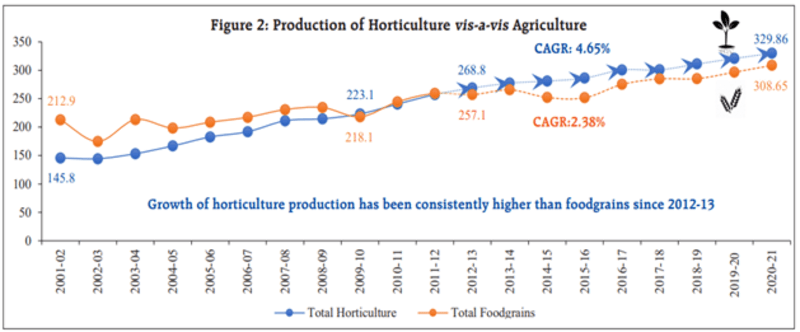
What is horticulture?
- Horticulture involves the nurturing of plants in controlled environments like gardens and greenhouses, rather than the large-scale farming of agricultural crops.
- This encompasses the growth of a wide range of items, such as fruits, vegetables, nuts, seeds, herbs, sprouts, mushrooms, algae, flowers, seaweeds, and non-edible plants like grass, ornamental trees, and decorative plants.
- Additionally, horticulture extends to activities like plant preservation, the restoration of landscapes, garden and landscape planning, construction, and upkeep, as well as arboriculture, which focuses on the care of ornamental trees and lawns.
Significance of horticulture in India
- Rural development: It provides a way to generate income and employment in rural areas.
- Employment generation: Horticulture is a major provider of employment in India, particularly for women and the marginalized sections of society.
- Source of foreign exchange: Horticulture is also an important source of foreign exchange for India, with a significant portion of the country’s horticultural produce being exported to other countries.
- Food and nutrition security: Horticultural crops play a vital role in providing food and nutrition security such as vitamins and minerals to the people.
- Source of income: Horticulture is also a major source of income for farmers. It provides them with an opportunity to diversify their incomes.
- Protects the environment: The cultivation of trees and plants helps to absorb carbon dioxide, reduce air pollution and help to maintain soil fertility.
Challenges of horticulture
- Post-harvest losses: The post-harvest period exists from the time the food is harvested till the time it reaches retail markets for consumption.
- Inadequate warehouse and transportation: India's inadequate cold storage & warehousing, rail, road, and logistics systems impact the transport of horticultural products.
- Market Access: Lack of efficient marketing channels and infrastructure poses a challenge in reaching consumers and export markets.
- Biotic Stress: The states in India face pest and disease challenges due to their unique agro-ecological conditions. Pests like the Assam tea mosquito bug and diseases like blister blight affect tea and other horticultural crops.
- Climate change & water crisis: The horticultural crops are highly sensitive to climate conditions. Erratic monsoons, extreme weather events, water crises in west, central and parts of peninsular India and shifting climatic patterns result in crop failures and reduced yields.
- Less income to farmers: Despite, the rapid increase in horticulture production, it has not brought much optimism to the farmers in terms of income.
Steps taken by the government
- National Horticulture Mission (NHM): It is one of the sub-schemes of the Mission for Integrated Development of Horticulture (MIDH). It has the objective of promoting holistic growth in the horticulture sector.
- National Horticulture Board (NHB): It serves to encourage horticulture, aid farmers, and increase crop productivity and profitability in India.
- Horticulture Cluster Development: The Cluster Development Programme (CDP) is designed to leverage the geographical specialisation of horticulture clusters and promote integrated and market-led development.
- Rashtriya Krishi Vikas Yojana (RKVY): The scheme aims to provide financial support to states and union territories for the development of agriculture and allied sectors.
- Central Institute of Horticulture: The institute provides technical support on different aspects of horticulture.
- National Bamboo Mission: The Mission envisages promoting holistic growth of the bamboo sector by adopting an area-based, regionally differentiated strategy and increasing the area under bamboo cultivation and marketing.
Way forward:
- Diversification of crops: Promote diversification of crops to reduce dependence on a few crops.
- Export promotion: Develop export-oriented horticulture clusters in regions with suitable agro-climatic conditions.
- Invest in research and development (R&D): R&D is required to develop new and improved horticultural varieties that are disease-resistant and high-yielding.
- Develop infrastructure: Develop cold storage and transportation facilities to reduce post-harvest losses.
- Financial support to small farmers: Offer subsidies and loans to farmers for the purchase of high-quality seeds, equipment, and machinery.
- Promote contract farming: To ensure a stable market for horticultural produce.
Conclusion:
Thus, enhancing horticulture in India necessitates a comprehensive strategy encompassing government initiatives, technological progress, farmer involvement, and private sector engagement. Further, prioritizing sustainability, product quality, and market accessibility is crucial for unleashing horticultural crop potential.
Prelims PYQ
In the context of food and nutritional security of India, enhancing the 'Seed Replacement Rates' of various crops helps in achieving the food production targets of the future. But what is/are the constraint/ constraints in its wider / greater implementation? (UPSC 2014)
- There is no National Seeds Policy in place.
- There is no participation of private sector seed companies in the supply of quality seeds of vegetables and planting materials of horticultural crops.
- There is a demand-supply gap regarding quality seeds in case of low value and high volume crops.
Select the correct answer using the code given below.
(a) 1 and 2
(b) 3 only
(c) 2 and 3
(d) None
Mains PYQ
Assess the role of National Horticulture Mission (NHM) in boosting the production, productivity and income of horticulture farms. How far has it succeeded in increasing the income of farmers? (UPSC 2018)
Why the Lewis Model has worked in China, not in India
GS Paper - III
Context:
With manufacturing turning increasingly capital-intensive, India may have to replace the old farm-to-factory with a new farm-as-factory labour model.
About Lewis Model:
- The economist William Arthur Lewis, who lived in Saint Lucia, argued in 1954 about the immense opportunities for industrialization that exist for developing nations that have an unlimited supply of workers at subsistence levels.
- The subsistence earnings of labourers in agriculture, construction, domestic service, etc., as well as the ongoing population growth, provide an endless labour supply.
- Their withdrawal from the farm would not reduce agricultural output. Although, they can make the existing manufacturing industries more viable and amenable to productivity-enhancing mechanization.
- For this, it requires to pay wages just high enough to make men leave the family farm.
How does Lewis Growth Model Work:
- In a dual economy consisting of capitalists and subsistence sectors, the Lewis Growth Model operates in terms of inter-sectoral connections.
- For example, the agricultural sector has a huge number of surplus labourers, and if these surplus workers are withdrawn, then the net output of the agricultural sector will not be affected.
- These excess workers are subsequently absorbed by the industrial sector, triggering an increase in output and employment, ultimately resulting in economic growth.
How has the model panned out in India:
- Approximately two-thirds of India's labour force was employed in agriculture until the early 1990s.
- The share of the labour force in agriculture decreased from 64.6% to 48.9% between 1993-1994 and 2011–2012, as seen in the below chart.
- But not much of it was due to manufacturing, whose share in employment rose marginally, from 10.4% to 12.6%, during this period.
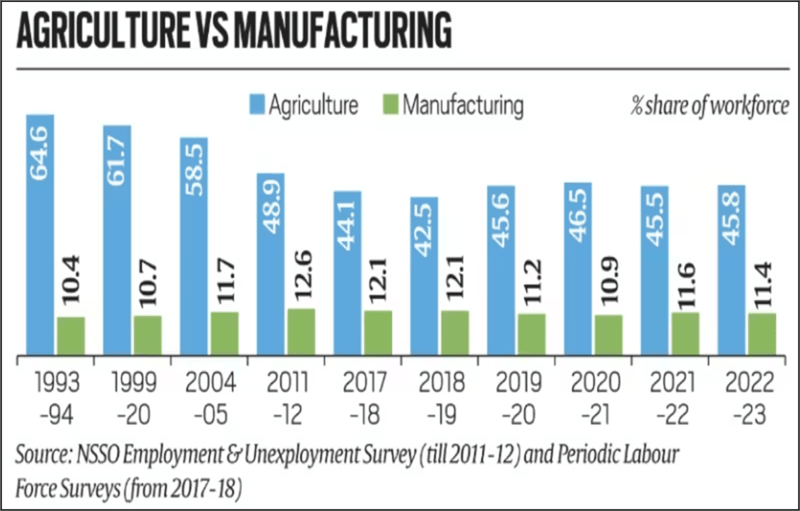
- The percentage of the labour force employed in the farm industry fell considerably over the next few years, reaching a low of 42.5% in 2018–19.
- According to the National Sample Survey Office's Periodic Labour Force Survey report for 2022–2023, the present share of agriculture in employment is still higher at 45.8%.
- The share of manufacturing in employment was at 11.6% in 2021-22, lower than the 12.1% seen in 2018-19.
- There haven't been many of the structural changes Lewis predicted, which involve moving excess labour from "subsistence" (agriculture) to "capitalist" (manufacturing) sectors. It has stalled in recent times.
- The movement of labour has been largely happening within the “subsistence” sectors.
- The jobs generated outside agriculture are mostly in low-paid services and construction, not in manufacturing and high-productivity services.
Implications of the model across the states in India:
- In states where a large portion of the labour force is employed in agriculture, manufacturing accounts for a smaller percentage of employment than construction and services.
- Even in states that rely less on agriculture, the workforce in services is at least two to three times that of manufacturing (in the table below).
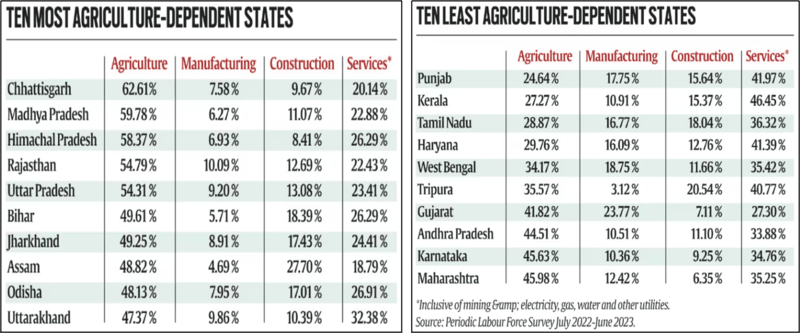
- Gujarat is the only state that seems to be closer to the Lewis model of labour shifting from farms to factories. Nearly 24% of its workforce – more than twice the national average – is employed in manufacturing, which is almost as much as in services.
|
The Lewis model had relevance for India in the fifties. It was a time when industry was synonymous with textile mills employing large numbers of people. Even Mumbai then had mills, with workers drawn from neighbouring rural areas and housed in chawls (tenements) in the center of the city. |
Potential factors supporting the feasibility of the Lewis model in India:
- India still has a near-unlimited supply of surplus labour working in subsistence sectors.
- India has a good working-age population.
- NITI Aayog is working on a “new” economic development model for India, exploring the scope for remunerative job creation “in and around agriculture” itself.
- Such jobs needn’t be on the farm, but outside it - in the aggregation, grading, packaging, transporting, processing, warehousing, and retailing of produce or supplying inputs and services to farmers.
- The use of grain, sugarcane, and oilseeds as bio-fuel is already growing, and so can the crop stubble and residues that farmers are now burning in the fields.
- There is also rising demand for bio-based products, whether as cosmetics and medicines, building materials, polymers, specialty chemicals, or even insecticides and fertilizers.
Conclusion:
The Lewis model describes a path whereby a developing economy can foster the growth of a new "capitalist sector," which will employ a growing share of the excess labor available from the subsistence sector. Over time, this capitalist sector can come to eclipse the subsistence sector, causing the overall economy to grow.
News in brief
Exercise KAZIND-2023
Context
The exercise is being conducted in Kazakhstan from 30th October to 11th November 2023.
About:
- This is the 7th edition of the joint military exercise between India and Kazakhstan.
- It was initiated in 2016 as “Exercise Prabal Dostyk” and has been upgraded to a company-level exercise and renamed 'Exercise KAZIND'.
- This year, it is a bi-service exercise, including the Air Force
- Both India and Kazakhstan will practice counter-terrorism operations in a sub-conventional environment under the United Nations mandate.
- The exercise will include tactical drills such as raid, search and destroy operations, small team insertion and extraction operations, and counter unmanned aerial system operations.

Haemoglobin
Context
Scientists find in major discovery that Haemoglobin is not used only in blood.
Significance of the discovery:
- It has been uncovered that haemoglobin is distributed in various tissues and organs, suggesting its participation in numerous physiological functions.
- This discovery has the potential to transform the realm of medicine by offering fresh perspectives on illnesses and facilitating the development of precise therapeutic approaches.
About Haemoglobin:
- It is the iron-containing oxygen-transport protein present in the RBC of almost all vertebrates (the exception being the fish family Channichthyidae) as well as the tissues of some invertebrate animals.
- Haemoglobin in the blood carries oxygen from the respiratory organs (lungs or gills) to the other tissues of the body, where it releases the oxygen to enable aerobic respiration which powers the animal's metabolism.
- Haemoglobin levels vary from person to person. Men usually have higher levels than women.
Cloud Aerosol Interaction and Precipitation Enhancement Experiment (CAIPEEX)
Context:
The Cloud Aerosol Interaction and Precipitation Enhancement Experiment (CAIPEEX phase-4) was conducted in Solapur city during the summer monsoon period of 2018 and 2019.
Objective:
The main goals were to create a cloud seeding methodology and examine the effectiveness of hygroscopic seeding in deep convective clouds.
Findings of the study:
- It was discovered that, in suitable circumstances, cloud seeding works well to increase rainfall in a certain area.
- The seeded clouds produced more rainfall than the unseeded clouds.
- According to the study, not all cumulus clouds that have undergone cloud seeding result in precipitation.
- It was observed that 20–25% of cumulus clouds result in rainfall if cloud seeding is done correctly.
Working procedure of ‘Cloud Seeding’:
- Calcium chloride flare was used for seeding the clouds.
- The seeding was done at the base of the warm convective clouds and at a time when the clouds were in their growing stage so that the seed particles could enter the clouds with minimum dispersion.
Additional information:
